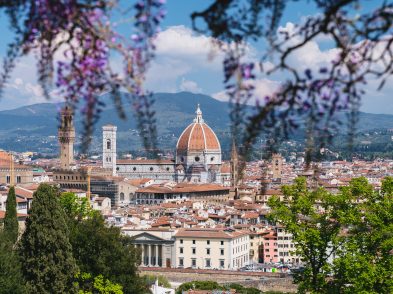Could they
possibly have known what they were witnessing that day? Could they have known,
as they sat under the muse-frescoed ceiling on via Tornabuoni, that they were
seeing the beginning of something that would invoke passion, tears, love
affairs, scandals and red carpets for the next 500 years?
It was the 1597 pre-Lent festivities in Florence, and a group
of men and women had gathered for a new type of entertainment in the home of
Giovanni de’ Bardi. A true Renaissance man, de’ Bardi was a solider, humanist,
musician, composer and patron of the arts, and he gathered around him a group
of other like-minded men, united by the belief that modern music had become
corrupt. They believed contemporary music, with its many voices and
conflicting, overlapping melodies, was too confusing to the ear.
Modern composers, they insisted, didn’t know how to move listeners or
provoke emotional states. And the words? The words, they said, were
unintelligible. These men, the Florentine Camerata, wanted a return to the old
style of Greek tragedy, which they believed had been sung instead of spoken.
They were seeking the beauty of a simple line of music with only six
instruments and a few solo voices.
What they found was the world’s first-ever opera.
The musical style developed by the Florentine Camerata and employed by
composer Jacopo Peri was a combination of old and new, the best, they believed,
of both points in history. Reaching back in time to ancient Greece they found
the inspiration to invent monody and the recitativo style of singing
(sung speech), but then added modern instruments, costumes and a humanistic
point of view. Librettist Ottavio Rinuccini retold the Greek myth of Apollo and
Daphne. But unlike the Greeks of ancient times, he wasn’t using the myth to
explain current rituals and the ways the world worked. He presented it from the
eyes of modern times, a time that reveled in beauty, art and humanism.
This first opera, Dafne, was performed on via Tornabuoni in
Palazzo Tornabuoni-Corsi, a palazzo that now, 500 years later, is being
developed by Tornabuoni srl into 36 luxury vacation apartments managed by Four
Seasons Hotels and Resorts. It isn’t too much of a stretch to see that the
process used by the modern architect, Luciano Fabbri, is very similar to the
process used, all those years ago, by the Florentine Camerata. They took the
value of the ancient and combined it with the beauty of the modern, just as
Fabbri reaches back through more than 500 years of art and architecture,
restoring grand staircases, sculptures and frescos, and combining them with
some of today’s highest quality and best looking furniture, electronics and
appliances.
The building, which now takes up almost a whole city block, began as one
of a grouping of residences known as the Florence Society of the Towers.
Giovanni Batista di Francesco Tornabuoni began the tower’s unification in 1466
after buying the eight towers facing via Tornabuoni and hiring an architect and
sculptor to oversee the project. This was no regular architect however, but the
same Michelozzo Michelozzi who succeeded Brunelleschi as capomaestro of the
Cathedral of Florence.
Over the next half-millennium the palazzo changed hands every 50 to 100
years, from Medici, to Corsi, two cardinals, a future pope, and other powerful
families. Each owner preserved the valuable art and architecture of previous
generations while hiring the most famous artists and architects of their own
time to decorate, change and rearranging it according to their needs. After all
these years, number 16 via Tornabuoni has become a labyrinth of beauty, an art
history lesson-all at a single domestic address.
Today, seeing the value in what came before, yet not scorning the value
of what we, as a modern, technological society, have developed, Four Seasons is
continuing in the tradition of past palazzo owners. Today a large staff of art
restorers work amidst stainless steel Boffi kitchens, top-of-the-line Bang
& Olufsen entertainment centers and stunning designer furniture to preserve
the works of the great artists and architects like Michelozzo, Agostino
Ciampelli and Ferdinando Ruggieri. The effect is simultaneously modern and
classical.
And so the palazzo is like music, like the opera that was brought to
life within its walls. Every generation of masters leaves their mark, keeping
what was beautiful and valuable and adding what is innovative and new. In
opera, composers over the years have added modern instruments and larger
orchestras. They have inserted ballets, and used new, quotidian story lines.
The style of singing has also changed from the wholly recitativo-style
(the sort of singing-talking that Jacopo Peri used exclusively) to a new mixture
that uses the recitativo as an introduction to what today we think of as
a more dramatic and lyrical style. It is the style of the famous arias, where
sopranos die, lovers unite and men march off to war. It is the style of the
songs you walk away humming when you leave Boboli Gardens after one of
the outdoor operas by Verdi or Puccini.
So would the men and women in that room on via Tornabuoni ever have
guessed at what they were beginning that night? That 500 years later in a city
much changed and much the same, there would be a girl from the other side of
the world, from a county that didn’t yet exist, who rode to their city in a
flying metal carriage to study the art form whose birth they witnessed? And
what would they have thought had they imagined that room, 500 years later: a modern
opera singer’s voice soaring up to the frescoed ceiling from the top of a stack
of Bang & Olufsen boxes?
I think they would have been proud.




